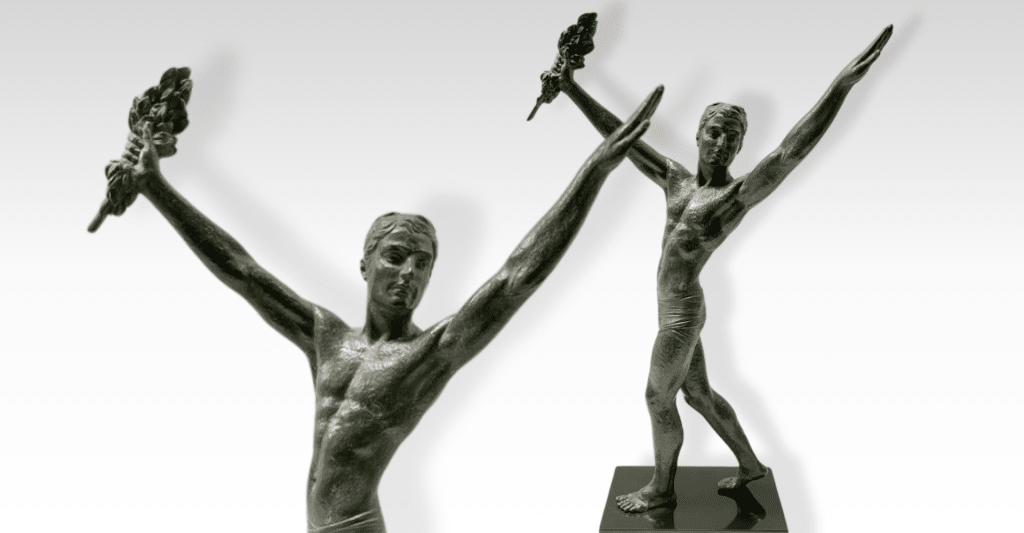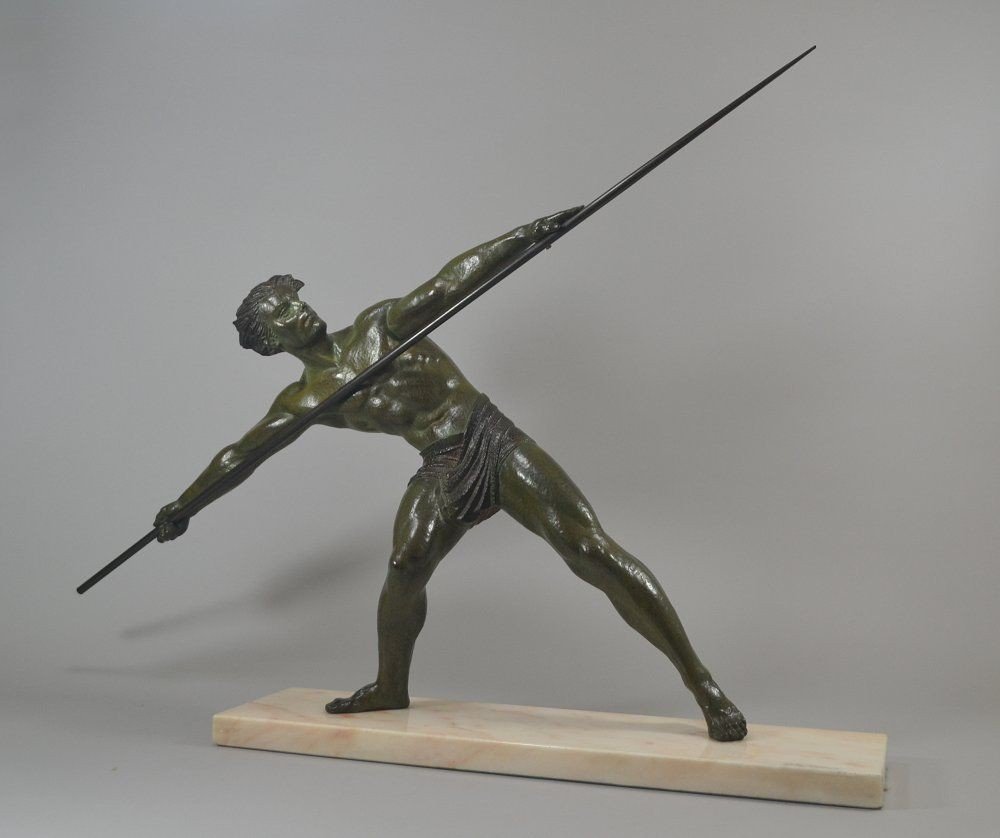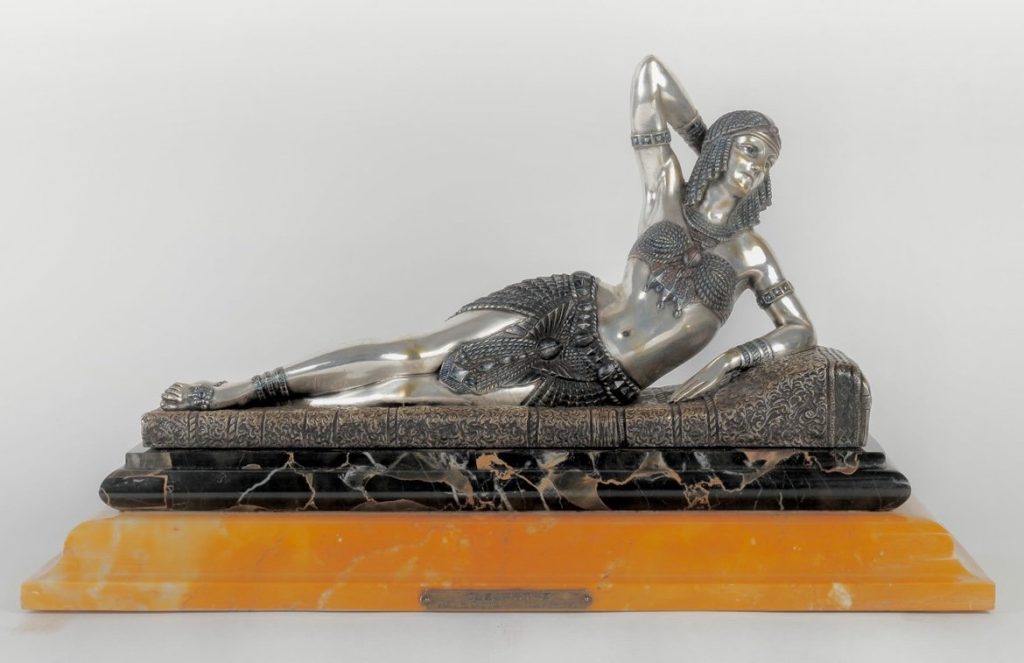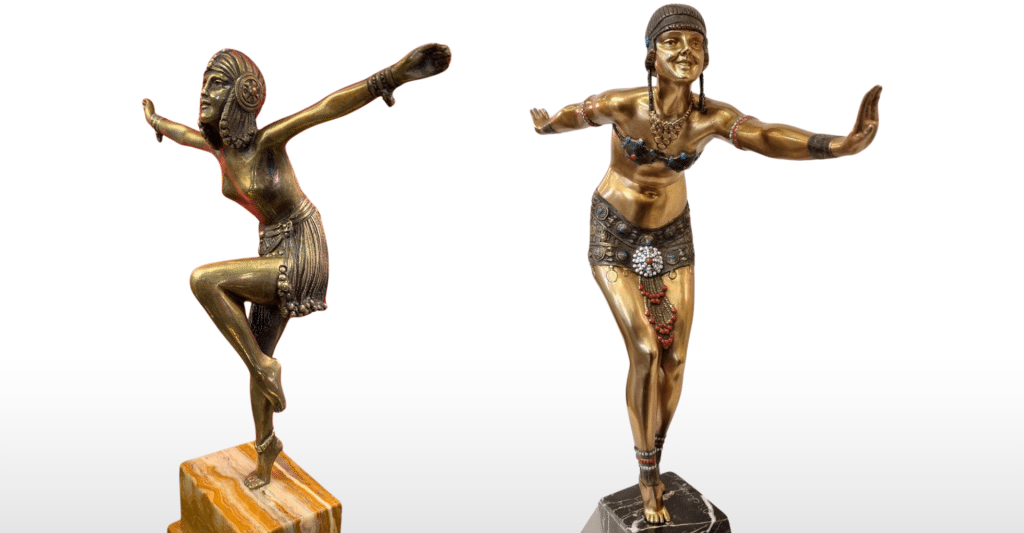The Paris 2024 Olympics are in the starting blocks. Did you know that Paris hosted other Summer Olympic Games in 1924? Then, let us celebrate with art, not only these new Olympics but also the 100th anniversary.
1924 was at the onset of Art Deco. Therefore, we are turning the spotlight today on Demetre Chiparus (1886-1947), an emblematic sculptor of Art Deco in France. Even though sport was not his primary focus, he created decorative sculptures around athletes. We will also tell you more about his areas of specialty (dancer and women statues, many of them in chryselephantine). But with no further ado, let’s jump into the story now!

A hurdler by Demetre Chiparus around 1920, imbued with the Art Deco style. © AG Antiquités
The Athletes Sculpted by Chiparus
Of course, all athletes strive for victory. During Greek antiquity, trophies could be of several types, sometimes crowns of olive trees, sometimes celery, laurels… However, by the early 20th century, laurels were the unequivocal emblem of the first place. Chiparus must have not hesitated for what the winner would exhibit in his hand as a token of his triumph.

Pair of Trophy / Triumph sculptures by Chiparus under his J. Darcourt pseudonym. © Au Fil du Temps Belgium
Chiparus would mostly sign ‘D.H. Chiparus’ (for Dumitru Haralamb Chiparus, his birth name) or ‘Chiparus’. However, the sculpture above is signed ‘J. Darcourt’. Like many artists of his time, Chiparus used various pseudonyms depending on the foundry or editor he was working with—the equivalent of having different brands for different markets.

Chiparus’s sculpture of an archer drawing his bow, titled “Age of Bronze”. © Deconamic
We can notice some strong commonalities between the two archers and the javelin thrower displayed here, in the body positions giving the most flattering exposure of the torso, leg, and arm muscles. The light catches in all the curves thanks to the details and the patina.

An Archer, sculpture by Demetre Chiparus. © Antiquités François Frères
Chiparus usually started his work with sketches. Then, he made a model in plastiline (a type of modeling clay invented in the 19th century). The statue was cast in bronze or spelter. An important decorative aspect of his sculptures lies in the various patinas: silver, gold, and shades of green. They were sometimes cold-painted or enameled. The base, in marble or onyx, is an integral part of the artwork to enhance the sculpture.

Javelin throw sculpture by Demetre Chiparus. © Frenchcab
These athletes have spectacular dimensions compared to the more well-known dancers of Chiparus. The base length of the three works of art above goes between 75 to 89 cm. What eye-catchers!
Men and Women in Sports in 1924
These statues are the true reflection of the beauty ideals of the 1920s and 1930s. Don’t you see a bit of Johnny Weissmuller in them? If Weissmuller is most known for starring the first Tarzan on the screens (between 1932 and 1948), he first won four Olympic medals in Paris in 1924, including three Olympic titles.
Did you notice the absence of women among Chiparus’ athletes? It is simply representative of the virtual absence of women in sports at the time. Practicing a sport in public was deemed inappropriate for a woman except for those traditionally practiced by the aristocracy such as tennis, fencing, horseriding, swimming… However, for Chiparus, women are on the contrary at the center of his art.

This gilt-bronze statuette of Suzanne Lenglen is not by Demetre Chiparus. It was used as an automotive radiator cap. Lenglen, a French tennis star in the 1920s, was nicknamed the “Divine”. Unfortunately, she had to forfeit during the 1924 Olympics. © Petit Antiquités
Chiparus Signature Dancers in Chryselephantine
Chiparus is particularly known for his dancers in chryselephantine. As the Greek etymology of chryselephantine tells us, such sculptures in Ancient Greece were originally made of gold and ivory. Since the end of the 19th century, there had been a renewed interest in statues in ivory combined with metals other than gold, which blossomed during Art Deco.

A dancer chryselephantine sculpture, titled “Tanara”, by Demetre Chiparus. Inspired by the Ballets Russes. © Florin Antiques
The Ballets Russes (Diaghilev’s ballet company) were a significant artistic phenomenon in the 1910s and 1920s. They revolutionized ballet and influenced visual arts and fashion. It was a genius idea of Diaghilev to get the costumes created by designers from outside the ballet world, such as Alexandre Benois or Léon Bakst. There is no doubt that the aesthetic of “Cleopatra” or “Scheherazade” (to give only a few examples), and the abundance of the ornaments displayed by these costumes inspired Chiparus.

1911 lithograph based on a costume of Ivan the Terrible by Léon Bakst. © Galerie des Songes
Moreover, we can not miss the influence of the movies, a new art form at the time. The elegant women represented by Chiparus have a cinematic presence and their traits look familiar. They have the postures and magnetic charisma of Greta Garbo or Louise Brooks.

Two chryselephantine sculptures by Chiparus. Left: “Comedian” (© Art Revival). Right: “Innocence” (© Galerie Tourbillon).
Orientalism and Music Hall Inspiration
Chiparus (born in Romania near Ukraine) moved to France in 1912 to study at the Beaux-Arts of Paris. He lived in France for the rest of his life but reached wide international fame. His most successful years took place between 1914 and 1933.
On top of his Slavic background, there is no denying that Chiparus is a child of 19th-century Orientalism. Many of his statues have the exoticism and sensuality of the awalim as imagined by Westerners. In addition, there is a more particular Egyptian style Chiparus seemed to favor, likely explainable by the rediscovery of Tutankhamun’s tomb in 1922.

“Cleopatra” statue in silvered and enameled bronze on a portor and yellow Sienna marble. © Pascal Berro
Yet, these women wearing oriental-style garments are first of all Western women of their time exhibiting the moves and energy of the music-hall entertainers of the Roaring Twenties, such as Josephine Baker.

Bronze statues of dancers by Chiparus. Left: “Chain Dancer” (© L’Ouestampille). Right: “Phoenician Dancer” (© Galerie Achille Antiquités).
####
With this article, we concentrated on sports and the key specialties of Chiparus art. He represented women in different activities, children, and animals too. And there again, he tapped into the characteristic favorites of Art Deco: dogs—many greyhounds, panthers, deers, elephants, etc. Demetre Chiparus was truly a sculptor of his time. It is interesting to compare him with similar Art Deco artists, such as Pierre Le Faguay, Marcel Bouraine, or Max Le Verrier. Yet, Chiparus remains unique, his sculptures nearly instantly recognizable.
####
You May Like
Art Deco Sculptures | Art Deco | Chryselephantine | Bronze Sculptures












